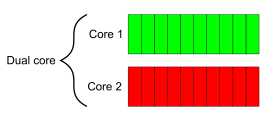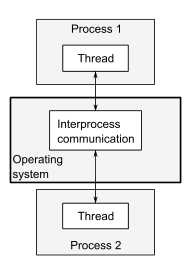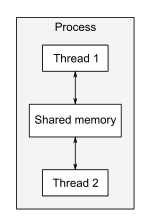标签:
未来芯片制造,如果突破不了 5nm 极限,那么在一段时间内 CPU 性能的提升,会依赖于三维集成技术,将更多的 CPU 核集成在一起,使得多核系统越来越普遍。
以前所谓的 C++ 多线程,一是受限于平台,多借助于封装好的 APIs 来完成,例如:POSIX threads,Windows threads 等;二是受限于单核系统,本质上都是“伪多线程”,通过线程的调度,使得单核系统可进行任务的切换,造成多线程的假象。
新的 C++11 标准,在语言层面上实现了多线程,其库中提供了相关组件,使得跨平台编写多线程 cpp 程序成为可能,最终能够在多核系统中实现真正的并行计算。
1 并发 (concurrency)
1.1 并发与并行
计算机中的并发,指的是在单一系统中,同时执行多个独立的活动。对于多核系统,它们在同一时刻进行的活动,则称为并行。
通俗的理解:当有两个人都在边吃饭边看电视时,对于一个人而言,吃饭和看电视就是并发,对于两个人而言,他们在同一时刻进行的活动,可称为并行。
1) 单核的任务切换 (task switching)

2) 双核的并行执行 (parallel execution)

1.2 线程与进程
如果将进程比作一套房子,那么住在房子里的人,其从事的各种活动 (比如,厨房做饭,客厅吃饭,卧室看电视),就是一个个的线程。现在又搬来一个人,则当两个人都在房子里,做着各自的活动时,程序便由以前的单线程变为了多线程。
有的房间 (比如客厅) 两个人都可以同时进出,这代表着进程中某些内存空间是共享的,每个线程都可以使用这些共享内存。有的房间 (比如厕所) 一次只能容纳一个人,先进去的把门锁上,后到的人看到锁,就在外面等待,直到先进去的人把锁打开,这就是“互斥核” (mutex)
在应用程序中,具体利用到并发编程的,一是多进程并发,二是多线程并发,如下图:


(1) 多进程并发 (2) 多线程并发
2 程序示例
实现多线程需要 1) 头文件 <thread> 2) 单独的线程函数 threadFunc() 3)线程对象 thread t(threadFunc) 4)等待线程 join()
#include <thread> #include <iostream> void threadFunc() { std::cout << "This is a thread!" << std::endl; } int main() { std::thread t(threadFunc); t.join(); std::cout << "This is main program!" << std::endl; return 0; }
输出结果为:
This is a thread! This is main program!
当使用 t.detach() 来代替 t.join() 时,主线程 main 不会等待新线程 t(threadFunc),只会独自运行到程序结束。
3 任务代替线程
3.1 两个问题
1) 线程耗尽 (exhaustion)
软件线程是一种有限的资源,当创建的线程数量多于系统所能够提供的,一个异常 std::system_error 就会抛出,程序便会终止。
2) 线程超额 (oversubscription)
当等待运行的线程 (ready-to-run) 多于系统硬件线程 (hardware threads) 时,线程调度器会为每个软件线程在硬件线程上分配时间片 (time-slice)。若一个线程的时间片结束,另一个线程的时间片刚开始时,上下文的切换 (context switch) 就会被执行。对于多核系统,当线程从一个 CPU 被切换到另一个 CPU 中时,会造成很大的资源消耗。
3.2 基于任务 (task-based)
基于线程编程 (thread-based),必须手动管理上面的两个问题,增加了编程的难度。
基于任务编程 (task-based),通过 std::async,可将问题交由 C++标准库处理,简化了程序。
1) 头文件 <future>
2) 单独的任务函数 taskFunc1 和 taskFunc2
3) 异步任务对象 auto fut1 = std::async(taskFunc1)
4) 获取任务函数返回值 fut.get()
#include <iostream> #include <thread> #include <future> std::string taskFunc1() { std::string str = "This is task1"; return str; } std::string taskFunc2() { std::string str = " and task2"; return str; } int main() { auto fut1 = std::async(taskFunc1); auto fut2 = std::async(taskFunc2); std::cout << fut1.get() + fut2.get() << std::endl << "This is main program" << std::endl; return 0; }
输出结果为:
This is task1 and task2 This is main program
小结:
1) thread-based programming needs manual management of thread exhaustion, oversubscription, load balancing, and adaptation to new platforms.
2) task-based programming handles most of these issues via std::async with the default launch policy
参考资料:
<C++ Concurrency in Action> chapter 1
<Effecctive Modern C++> chapter 7
标签:
原文地址:http://www.cnblogs.com/xinxue/p/5778270.html